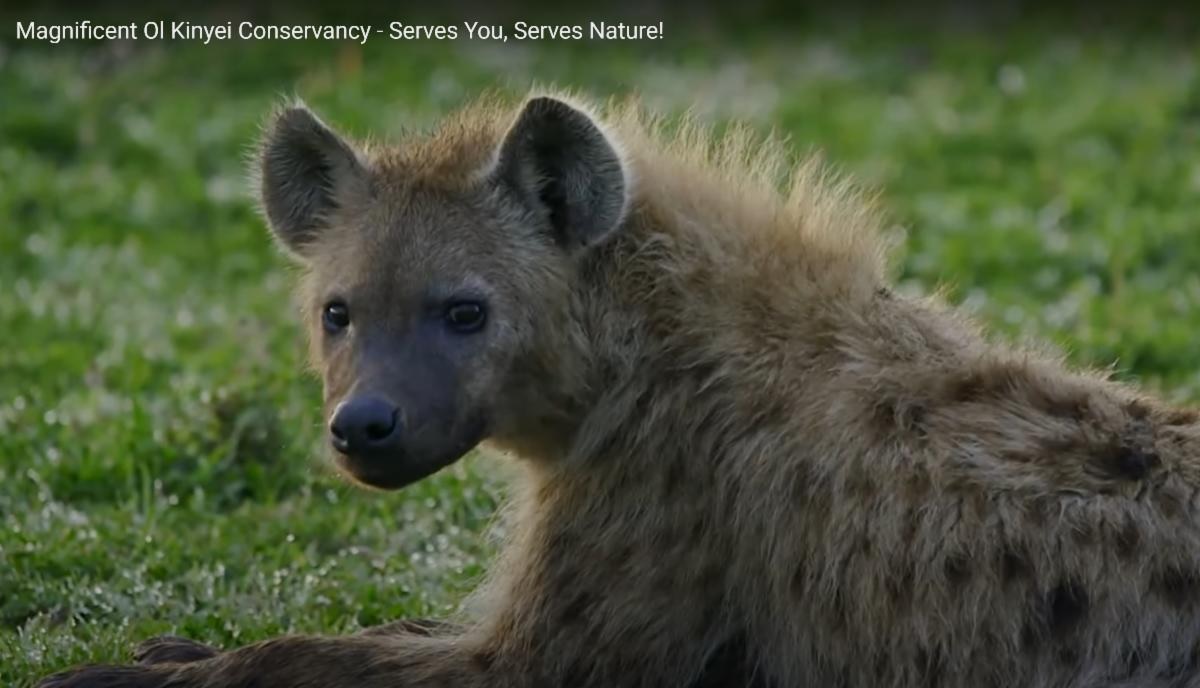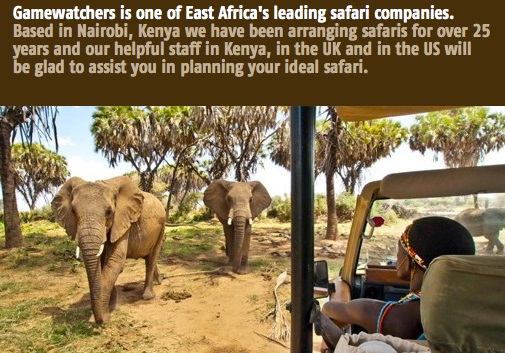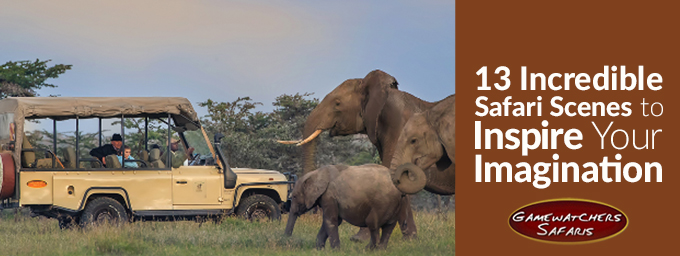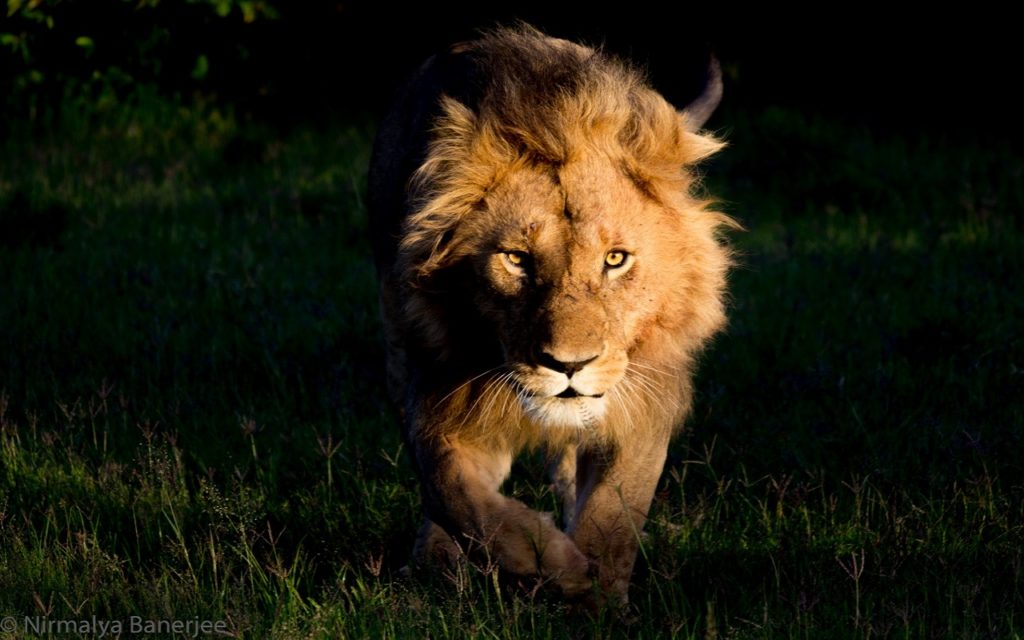
The latest news and wildlife sightings from Ol Kinyei Conservancy in the Maasai Mara brought to you by Nirmalya Banerjee at Porini Cheetah Camp.
Ol Kinyei Conservancy is 18700 acres of pristine wilderness that has been set aside as a wildlife reserve. Located within the Serengeti-Mara eco-system, it is renowned for its unspoiled and breathtaking scenery with diverse terrain. There is a broad variety of animals including African’s iconic species such as elephants, lions, leopards, giraffe, cheetahs and much more.
The Conservancy is home to Porini Mara Camp and Porini Cheetah Camp (and our Gamewatchers Adventure Camp in high season), and our guests have exclusive access to this land. Avid wildlife enthusiasts Nirmalya and his wife Jui Banerjee run Porini Cheetah Camp.
Come and experience Ol Kinyei Conservancy for yourself! To start your planning contact our dedicated team of Safari Advisers who will be delighted to help you put together your ideal safari.
Update from Nirmalya
Tuesday 17 July 2018
Nebati’s Cubs Get Foxed!
We’ve been seeing the two cubs with Nebati the Cheetah since they were just fur-balls, so though they’re much bigger now, it’s always a pleasure to come across them.
This morning, the three were just walking across the savanna when the two cubs took off. Mum Nebati was unmoved. The cubs chased a Bat-eared Fox who was caught in the open but was smart enough to run towards a bush which gave it some protection. Here it took a stand, even coming out to snap at the young cheetahs.
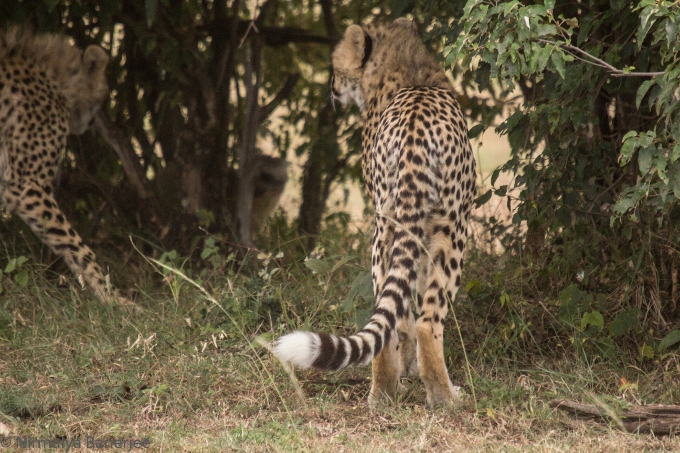
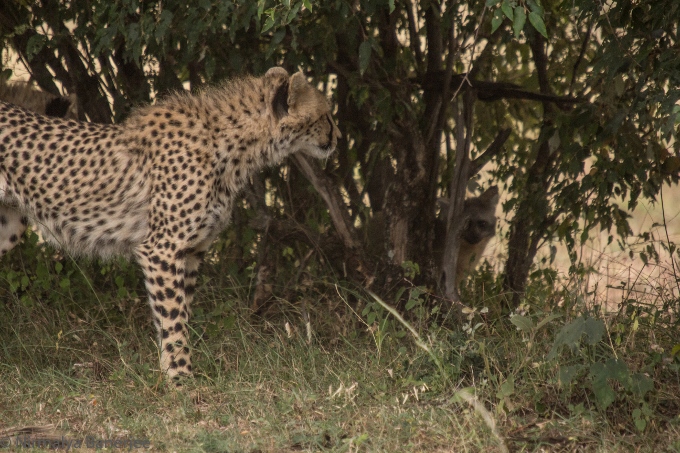

The two tried to approach it from various directions but were out-foxed by their intended prey. Nebati watched the action for a few minutes and then getting worried that the cubs might get injured, called them off.
Wednesday 11 July 2018
Poor Senteu
Having lost cubs earlier to marauding lions, the Fig Tree boys are determined to protect the current set of two cubs – less than two months old and still smaller than house cats. With great diligence they ensure that at least one of them is always on guard duty. Today it was FIGaM2 Senteu’s turn.
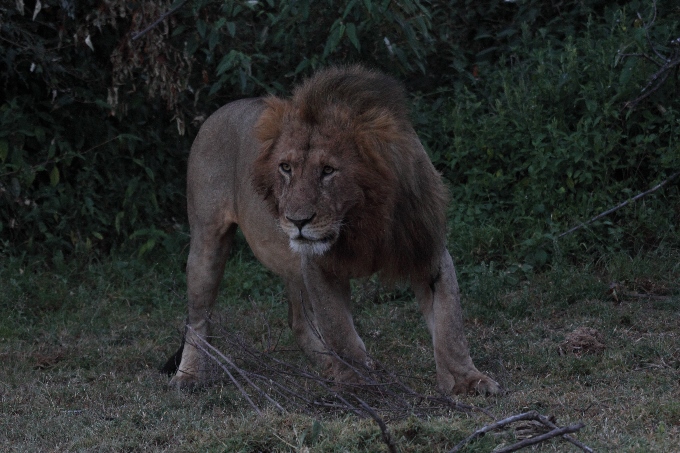
However lioness mums are always ambivalent about letting their cubs’ dads near their offspring. Male lions are notoriously ill-tempered and have been known to kill or injure even their own cubs, eager to play with them, with a cantankerous swipe. As we watched Naramat and her two cubs, Senteu came and parked himself about ten metres away from the others. Naramat wasn’t happy, growled and when that hint wasn’t taken, snarled at Senteu.
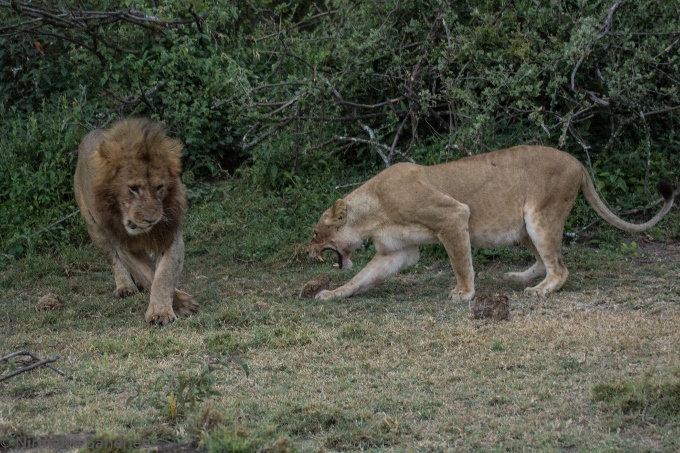
He didn’t react very much and sat down after moving away a little. The cubs then came out of the bush and approached the male lion. This was too much for Naramat who lunged and snarled at Senteu- as if it were all his fault.

Thinking that she had suitably subdued the lion, Naramat relented but then the cubs started walking again towards him. Naramat had had enough. This time her reaction convinced Senteu that discretion is indeed the better part of valour, and he walked till he was about a hundred metres away. Far enough to keep Naramat quiet but close enough to respond quickly in case of any danger.
Tuesday 3 July 2018
Lions usually have little to fear in the jungle. They are stronger than anything faster than themselves and faster than anything stronger. But all this is true of the adults. The cubs are at risk, mainly from intruding male lions but also from hyenas in packs and Martial Eagles swooping in from above.
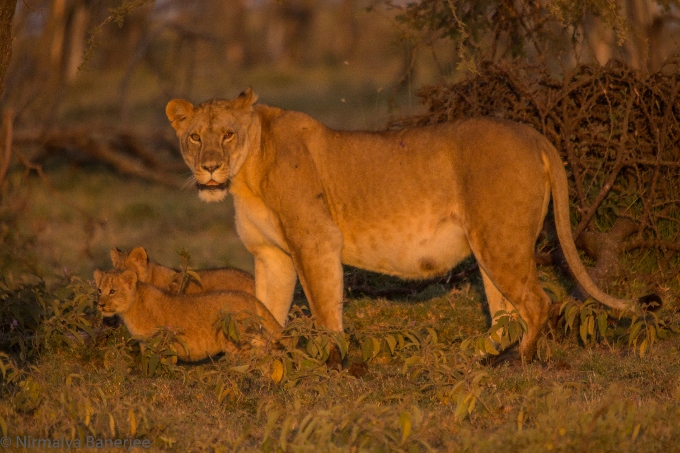
Having lost a set of cubs earlier to interloper lions, Naramat, Nempiris and the Fig Tree boys seem determined to be on alert this time. It seems strange but I’m not sure their effort could be bettered by a professional security detail tasked with protecting a high-value target, through layered security.
At night the Fig Tree boys split up and aggressively patrol their territory sanitising it to provide distant cover by calling out loudly to warn away other lions. The cubs are hidden away most of the time but when they do have to come out, one of the Fig Tree boys is at hand to provide proximate cover by hovering a few hundred metres away. And of course mum Naramat, and aunt Nempiris, provide close cover.

We came across the two lionesses just as they prepared to leave a thicket with the cubs. Olonana was perhaps 500m behind us. First Naramat came to the edge of the clearing with the cubs, and waited. Then Nempiris bounded in and came to the front, tail held stiff, always a sign that the cat is on alert and ready to spring into action.
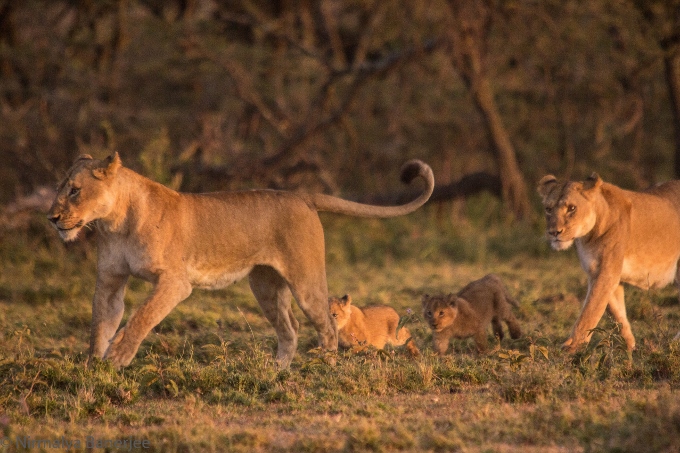
Once the two adults took up position, the two cubs went between them and the cats proceeded into the clearing, walking briskly.
Thursday 14 June 2018
Cats have sensory perception – beyond sight – that mere humans can only marvel at. We came across the three Fig Tree boys all sprawled out beneath a bush, and assumed they had called it a day. But Batian abruptly got up and Senteu followed him. Olonana though continued sleeping while his brothers walked away. When he finally reacted and stood up, his siblings were about 100m from him. Batian solicitously kept scent-marking the bushes as olfactory beacons for Olonana to follow.

As Olonana started walking, he kept his nose close to the ground.

It was a quiet morning and all was calm till events diverged from plan. Batian came face-to-face with a human being albeit at a distance of about 20m. I don’t know know who was the more surprised but certainly Batian was the one very startled. He jumped up, got his legs in a twist and shot off at a 90° angle to where he was going. Senteu faithfully followed him.

Meanwhile Olonana following at a distance was blissfully unaware of what had happened. He kept sleep-walking till he came to where Batian had taken off. As you can see in the video, he came to a stop, tail twitching, seemingly nonplussed. But only for a few moments. He stood and perhaps heard or smelt his brothers. Be that as it may, he too turned sharply from the direction he was going and unerringly took the path his brothers had taken.
I’m sure he soon came across Batian recovering from his fright and no doubt thanking his stars for his narrow escape from a dangerous human being.
Monday 28 May 2018
The Porini Cheetah Camp opened on 1 June 2017. We came to live in it a few days before that and so have just completed a year in the camp. In this period, we have been hit by flash floods, been in a stalled car in close proximity to lions, got stuck in sticky black cotton soil with no rescue car readily available, chanced upon a Cape Buffalo in the dark close to our tent and experienced other sundry incidents inseparable from life in the African bush. What has kept us going- apart from the fact that we like living in the jungle- is our conviction that this unique model of using commercial tourism for the benefit of humans and wildlife alike, is inherently sound and needs to spread far and wide. So it was wonderful to receive recent affirmation of the worth of what we are doing.
At the end of April, some of our clients returned distraught from a dawn game drive to report having seen an elephant behaving strangely. We got into our pickup and drove out to take a look. We found two elephants, with one indeed behaving in a most unusual manner. It had evidently been abandoned by the herd while another elephant stayed back to protect it but unable to help. We couldn’t approach it for a closer look because an elephant in pain might be unpredictably aggressive, but returned to the camp to report what we had seen, to the elephant protection unit of the Kenya Wildlife Service that is stationed in the conservancy.
It had started pouring by then but undeterred, a contingent of rangers went to locate the elephant in need of help. It returned unsuccessful as the two pachyderms had left the place and the rain was making it hard to drive around to look for them. The rangers went back the next day but to no avail. They persevered and finally found the elephants a couple of days later. An inspection showed that the elephant was injured. A vet was called in, the animal was darted and attended to and beyond that there wasn’t much for anyone to do but to hope for the best.
For a few weeks thereafter there were no reports of the elephant having been sighted, till finally earlier this week it was seen again. What a difference the intervention had made! It was still limping but had been reunited with its herd and importantly able to keep up with it. It was also grazing normally, always a sign of fairly good health. All thanks to a group of tourists on safari that had noticed an elephant in trouble and was concerned enough to have reported it.
Friday 18 May 2018
Many people feel we must live an idyllic life in the bush. Indeed we do. On most days. Yesterday was the other kind.
We had been hearing lions calling close to the camp overnight, so early in the morning we jumped into our pickup to take a look. Not 200m behind the camp we found the Fig Tree boys. As the nomads have grown older they spend more and more time alone and so it is rare in recent times to find all three siblings together. We were therefore happy to see Batian, Senteu and Olonana not far from each other. As always, Batian was with a lioness- Naramat.


I parked the car- with engine switched off- so that we were between Batian and Naramat on the one hand and Senteu and Olonana on the other. The lions were relaxed and even dozed off at times.

Just then Batian and Naramat got up and I tried to start the car to re position it. Nothing happened. My pickup, just a few months old, that was in great condition refused to start. Try as I might, there was nothing I could do. With lions on either side about 10m away I couldn’t even get off to look under the bonnet.

There was nothing for it but to call the camp for help. Since we were so close to the camp a vehicle reached us in a few minutes. As it pulled alongside our pickup we quickly opened the door and jumped into the relief vehicle with the lions looking on quizzically.
Later in the evening we went back to retrieve the stalled pickup. The lions had left but we couldn’t take a chance and had to drive around in a wide circle to ensure the cats weren’t in the vicinity. Luckily, diesel engines work on compression ignition and so a manual vehicle can be push-started even with the electrical system not working. This morning a cursory glance under the bonnet showed the battery terminals- both of them- were loose. A couple of turns of the spanner were all that were needed to fix the problem. How the terminals were loosened and importantly why they decided to play up, just when they did, in the proximity of lions will remain a mystery!
Friday 27 April 2018
We’ve had elephants and lions come right up to the perimeter of the Porini Cheetah Camp, and antelopes, buffalo and hippos walk through our grounds on occasion. So it’s easy to forget about the smaller animals that visit us.
It had rained heavily overnight yesterday and in the morning we found a Leopard Tortoise sunning itself on the lawn outside our lounge.
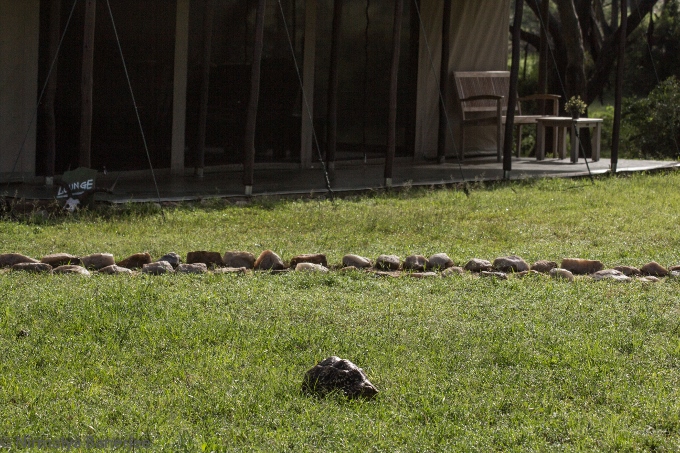
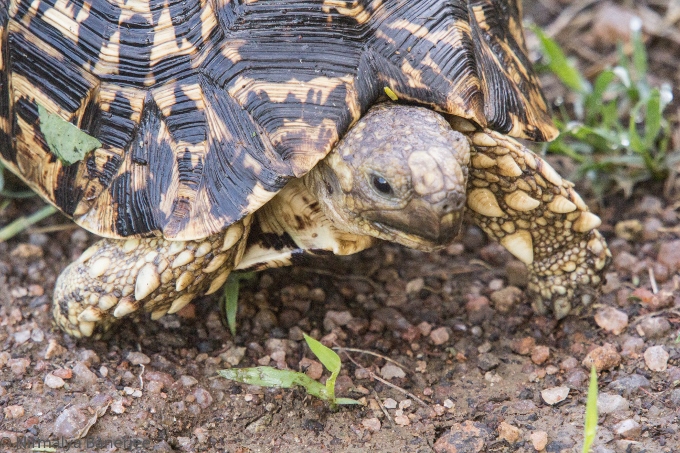
But then, it was uncomfortable with all the attention, and it wanted to get back into the Olare Lemuny stream that flows past the camp.
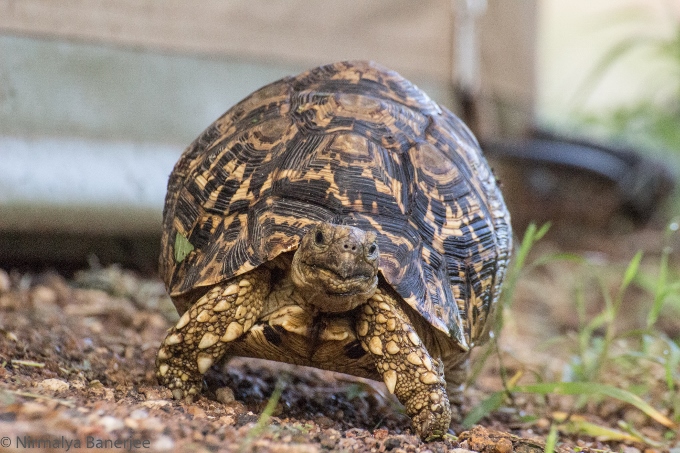
On the way it came across our outdoor dining set but undaunted, it navigated the obstacle course and made its way home.


Sunday 22 April 2018
Strange things happen in the bush. For example, this post that is really about lions but where the photos have only elephants.
We returned from a game drive after sunset. I walked into my office and after a few minutes when I looked up from my computer noticed a herd of elephants grazing quietly about 10m in front of tent#1, with the White Rock in the backdrop. They had been there all the while, but we hadn’t noticed them. I walked out to get a better shot, and this is all that was needed to raise an alarm. All the elephants poured out and vanished from sight, as if I was a huge threat. That I thought, was that, and there would be no further visits.

After 15 min I noticed the elephants had returned to the area outside our barrier and I went to photograph them. It had been raining heavily and the Olare Lemuny stream, to the left of the frame was in spate. I kept my camera down to watch the relaxing sight of elephants grazing on grass.
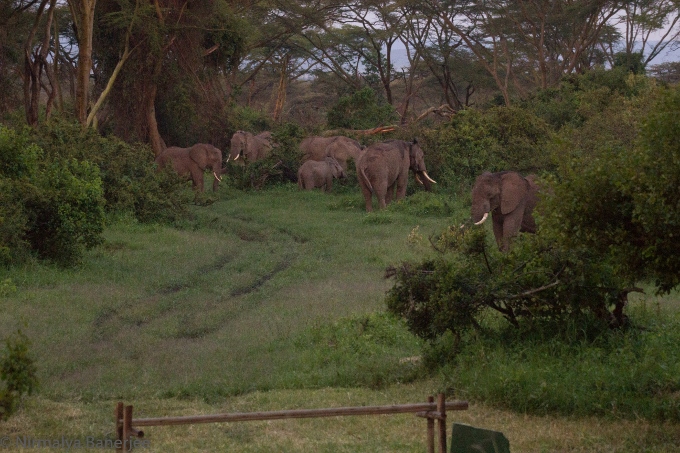
That is when it all happened. Olonana the lion suddenly appeared behind one of the bushes to the left just outside our barrier. He had swum across the torrent and then bounded up the gorge to be confronted by a herd of at least 40 elephants on guard to protect their babies. For a second, Olonana braked as he processed this information. Clearly, he didn’t relish the thought of swimming back across the Olare Lemuny, but there was no other safe exit. His only two choices were to cross the elephants or to come inside the camp. He decided on the lesser of the two evils and in a flash bounded across the track and darted between the two tuskers on the right, closest to the camp. The element of surprise allowed him to successfully run the gauntlet and escape unscathed.
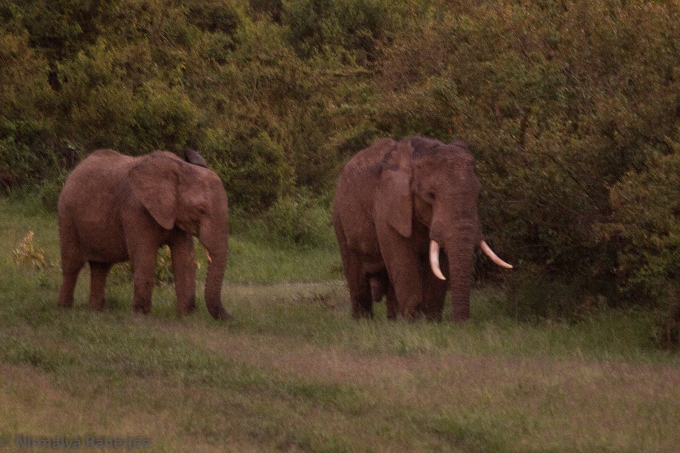
That is when the elephants reacted. They raised a ruckus and trumpeted loudly to warn Olonana against approaching them again. Across the stream we could see one of the other Fig Tree boys wondering how to join Olonana. By now the light was too low to either take photographs or identify the other lion. The elephants meanwhile started patrolling the area aggressively as you can see.
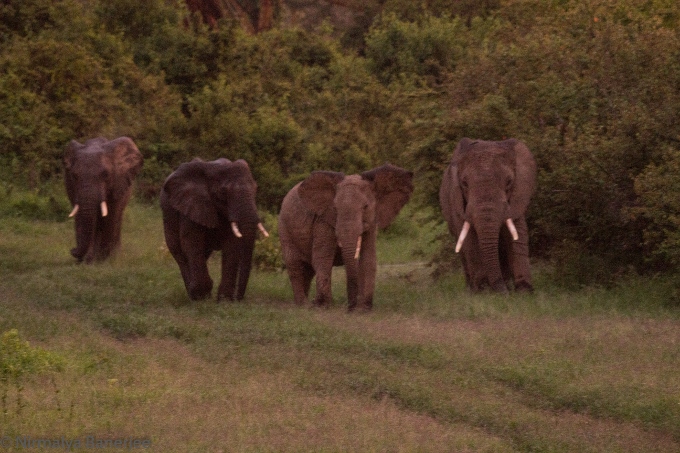
One of them even climbed the White Rock partway. The photo in very low light is terrible but you can see the elephant climbing the rock.
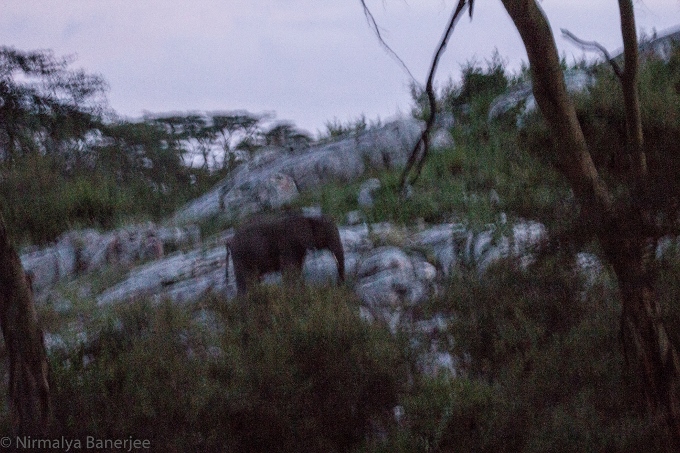
Meanwhile there was not a squeak out of Olonana. He waited for the elephants to calm down and then began a most comical symphony. Olonana called out mournfully. His brother across the stream forewarned by now of the presence of alert elephants, called back but made no move to cross the stream. Olonana called out again and so the cycle continued for some time. By now it was pitch dark and we had no clue what was happening, just 25m away from us. We thought things had quietened down and even the lions were quiet when suddenly after perhaps an hour there was a trumpeted crescendo all of a sudden. We realised the other lion had mustered up his courage and again taking advantage of both surprise and the cover of darkness, had run through the herd of elephants to join his brother.
Thursday 12 April 2018
Last night we heard lions calling all around the camp. This morning I was told about a herd of elephants passing close to us. I drove out to take a look and found it less than 100m away. It was a large group of about a hundred elephants. There were some young calves as well. The herd was agitated and moving very quickly indeed. Some of the elephants were trumpeting. I am guessing they had met the big cats and were keen to move the babies out of harm’s way.
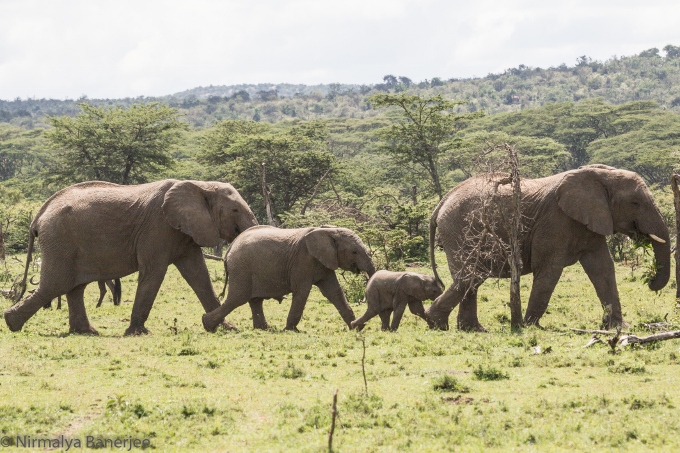
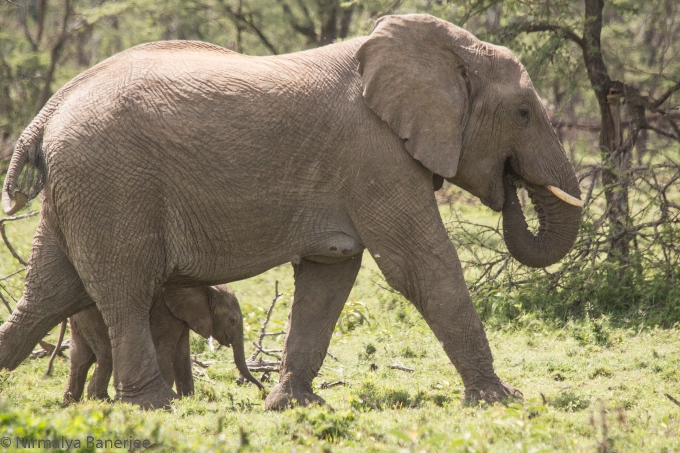
As I drove up to it, one of the adults swung out and mock charged me through the brushwood. I took the broad hint and kept my distance. The large group then walked up the hillside and soon melted away into the bushes, leaving only my photos to prove the presence of the pachyderms.
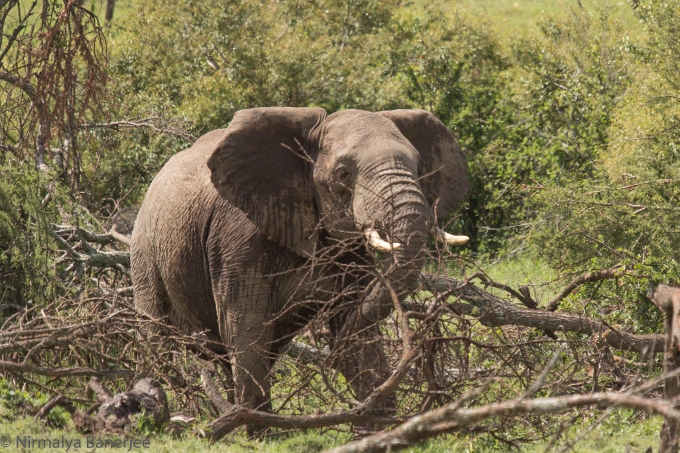
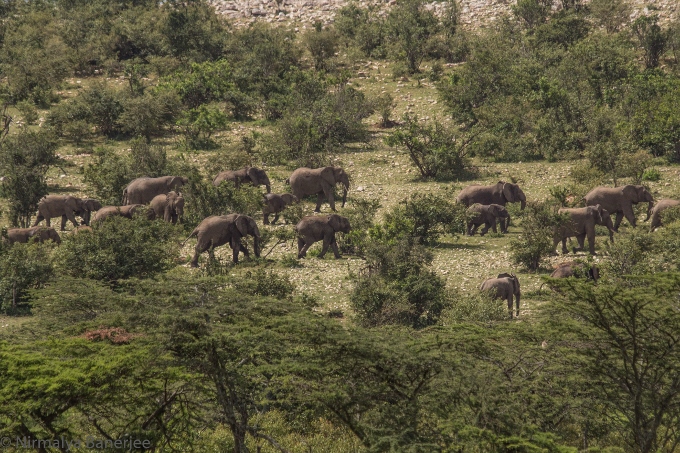
Wednesday 28 February 2018
Last evening a small family of elephants visited the Porini Cheetah Camp.

The youngest member of the family was just a few months old. Elephants with small calves sometimes approach human habitations because they think their calves will be safe from lions. But of course, they need to be sure that the humans aren’t dangerous either. So, the largest elephant in the small group swung out and came right up to the camp fire to check us out.

She spent about 30 min while we watched fascinated. All the while she was calm and non-aggressive but let it be known she was looking at us. Occasionally she raised her trunk to sniff at us.

Then the elephant relaxed a bit and started browsing on a bush and finally decided that we were harmless.

All the while the calf and its mother and older sibling browsed on some acacia bushes that were greener than the ones outside the camp because they are watered.

Once the elephant who had approached us, gave us a clean chit, she rejoined her family group and they all walked back to the Olare Stream that flows past the camp.

Friday 23 February 2018
One evening, earlier this week, we hadn’t lit the camp fire and so from around dinner time we could hear the lions calling. One was particularly close. The big cats almost never enter the camp but come closer when there is no fire. Lions usually call out to each other on dark nights in order to regroup. After dinner I went to my office tent to continue working and at about 9 pm, one of our guards came excitedly to my office to announce that he could see a lion outside the camp. I followed him for a closer look and from close to one of the tents we could see a male lion by torchlight, about 25m away. We stopped and we and the lion stared at each other. The lion realised that he had been lit up, and froze. Now 25m is really no distance for a lion and something that he can cover in a flash. Of course we didn’t really expect the cat to come towards us, especially since his posture suggested that he was ready to run away. Still, we didn’t dowse our torches in order to keep the lion in sight.
The lion we could see had fallen silent but his brother was calling away from beyond the ridge. It is an indescribably mesmerising feeling to be on foot in the African bush on a moonless night and see a big cat in a pool of light, while lion calls reverberate all around you. The lion in front of us was clearly uncomfortable at being illuminated on a dark night and flopped down on the ground. Even so, we couldn’t switch off the lights and, we stood our ground not comfortable with turning our backs to the big cat. Finally, the lion stood up and walked away into the shadows, too far for our light beams to follow. I returned to my office tent and my emails. It was only then that I realised in the midst of all the excitement I forgotten to grab my camera.
Friday 16 February 2018
The Gum Pole Barrier
While building the Porini Cheetah Camp, we had debated whether to put in gum pole barriers on the road leading up to the camp on either side. After all, ours was an un-fenced camp and so the barrier was just visual and psychological. Ultimately, we did put in the barriers, mainly to tell drivers unfamiliar with the camp, where to drop off their passengers.

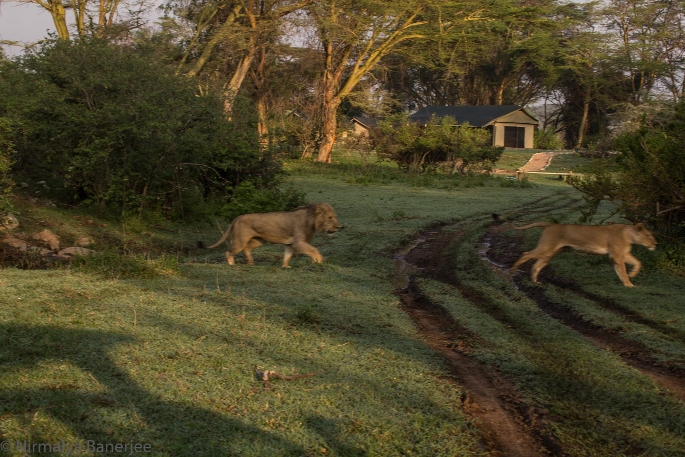
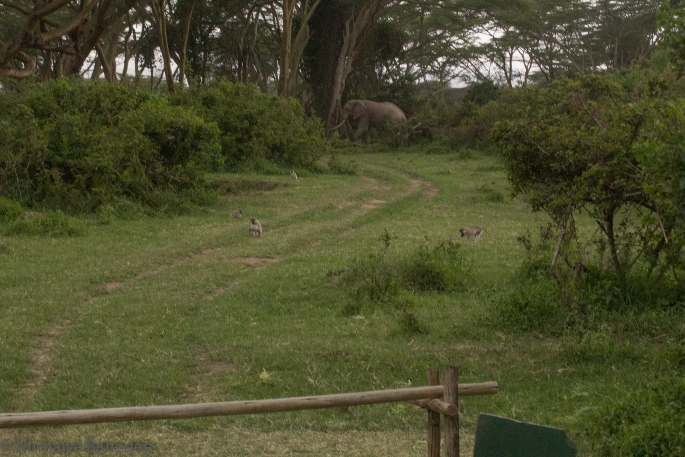
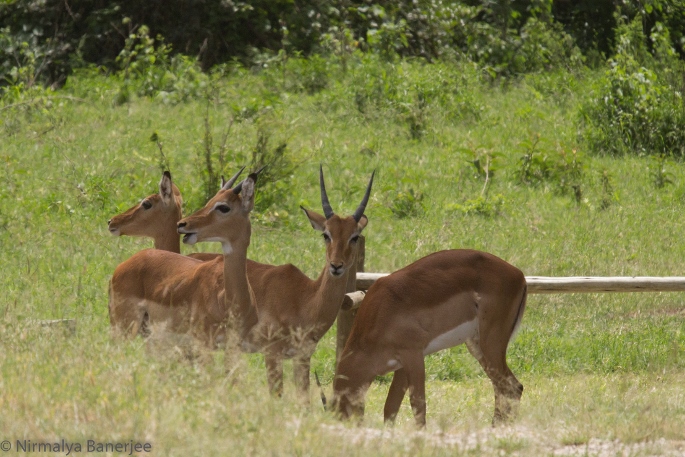
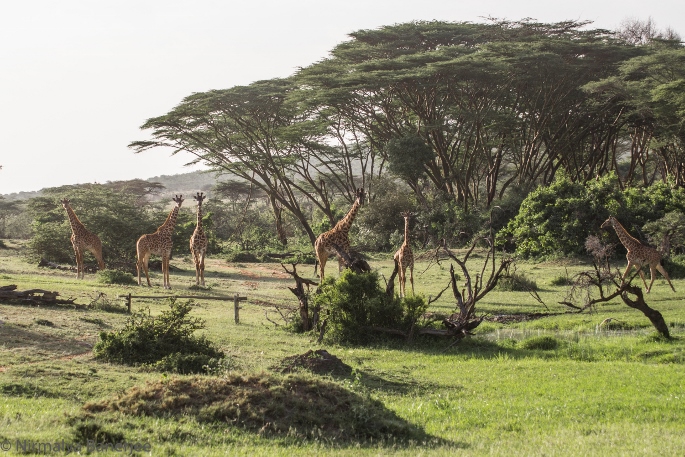
Our wildlife neighbours though understand well that the barrier represents a line demarcating their world from our impermanent bubble in the wild. We have wildlife coming right up to the camp but most usually they don’t venture far inside the barrier.
The photo of the lions was taken from just outside the camp, but all the others were taken from within. That photo along with the elephant’s, was taken last month. The others were taken this week.
The gum pole is indeed an important feature of our camp and so deserves to be the common element in all the photos in this post.
Thursday 8 February 2018
The African Wild (or Painted) Dog is a relatively rare sighting in the Masai Mara eco-system so we were delighted when a small pack of four dogs spent all of yesterday within a few hundred metres of our camp. They have a very large range and travel across it. The last time we saw them in Ol Kinyei Conservancy, was almost a year ago.
This morning we looked for them, but they were nowhere to be found. One of the dogs is collared to enable researchers to track them. Here you see them socialising by greeting each other at sunset before setting off.
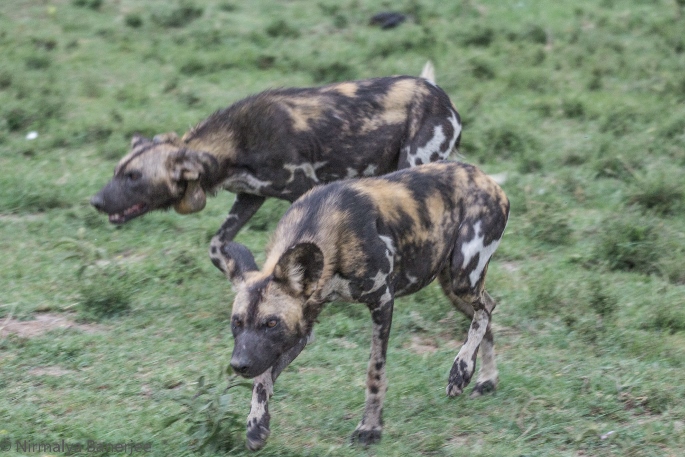
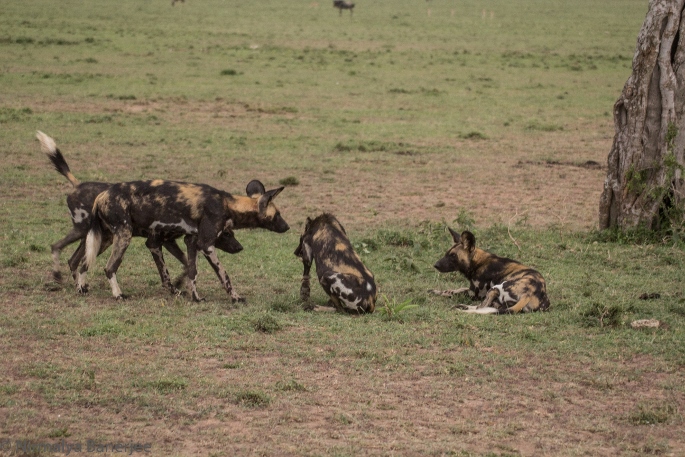
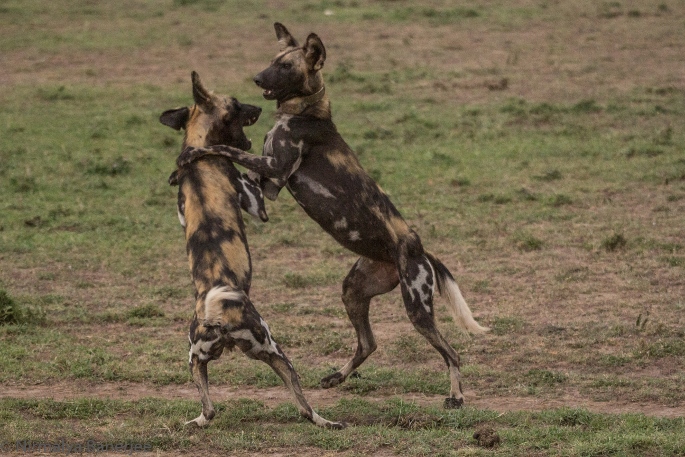
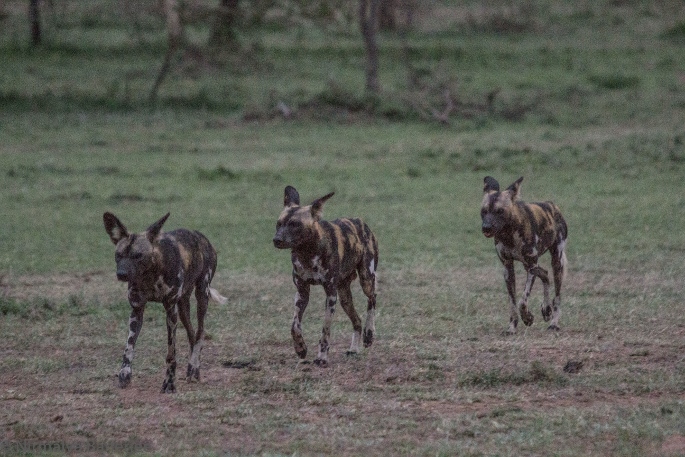
Wednesday 31 January 2018
Mara in the Long Rains
Porini Cheetah Camp during the long rains
April and May are traditionally the months of the Long Rains in Kenya. Many camps in the private conservancies have therefore been closed in this period. However, this year, we have decided to keep Porini Cheetah Camp open in this period. We have done so mainly because of the experience last year when the shifting weather patterns caused the Long Rains to virtually stay away from Masai Mara when it should have been raining. Then the rains returned with some vengeance in August and September when it should have been dry. The long-range forecast for this year is for the long rains to be delayed till May and then die down in the middle of July. April is forecasted to be drier than August and September which are traditionally dry months.
Another reason for keeping the camp open is that the access both to the airstrip and the main road to the conservancy crossing streams is now on newly built concrete causeways that are open except for a few hours after very heavy rain.
What can you expect if you visit during the Long Rains?
There is potential for weather related disruption, but it has to be emphasized that this can happen as a result of a cloudburst at any time of the year, including the months traditionally considered to be dry.
Usually the rain is for a few hours and not for days on end. If there is heavy downpour during the game drive, you can expect it to have it cut short as with the covers down, you can’t see much outside the vehicle. At the very least, if it just a squall, you can expect a period of interruption while you wait it out in the vehicle with covers down. If there is continuous exceptionally heavy rain for a few days, you can expect the tracks to be muddy and while our vehicles very good off-road there are certain streams that they might not be able to cross and there could some parts of the conservancy that are rendered inaccessible. Your bush breakfast or lunch might be interrupted by the rain and if you’re in the camp during a shower, you will have to use the umbrellas provided to walk to the dining tent.
So why even consider a visit during the long rains?
There are many attractions related to the rains, especially if you have a few days on safari.
1. April and May comprise the southern autumn and when it rains, the temperature can drop below 15°C. Masai Mara is at an altitude of about 5,000 ft and rain can make for very comfortable temperatures. This can be very pleasant especially if you come from a country where these are hot summer months.
2. The savanna is green and soothing to the eye.
3. This is low season, so you can expect low prices and great service. Even international air fares are traditionally low at this time.
4. The wildlife sightings are plentiful. This is because the wildebeests calve in March and this means that the big cats have plenty to eat and so are active.

The savanna is green, and plentiful game makes for increased big cat activity
5. When it rains the lions typically go up the hills but because ours is a private conservancy, we can usually follow them off-road and catch them drying themselves in the sun and of course when they hunt, we can position ourselves well if we see one imminent.

The lions sun themselves on the hills when the sun comes out
Monday 29 January 2018
The BOS Brothers
The three Fig Tree male lions came to Ol Kinyei Conservancy about 8 months ago and now seem to have settled down. In its relatively short time in the conservancy the trio has evicted the Sampu Enkare nomadic sub-adult males and in recent weeks appears to even be standing its ground against the powerful Rekero boys, Dongo and Caesar II who occasionally foray here. As these three boys have grown more confident of their strength, they often disperse at night to fully guard their newly claimed territory. This also means they need to regroup very early in the morning and so we are often woken before dawn, by lion calling sounds that we can hear from our tents.

The Fig Tree trio, August 2017, soon after they came to Ol Kinyei Conservancy.
Because of the high mortality rates amongst the big cats they are usually named only after they become adults. These young adult males have now been named, with the Masai guides in the conservancy, having arrived at a consensus that they should be named after the famous Masai Laibons or ritual leaders, Batian, Olonana and Senteu. The Mara Lion Project has added these names to its database so our lions now have names in addition to their designators FIGaM1-3.
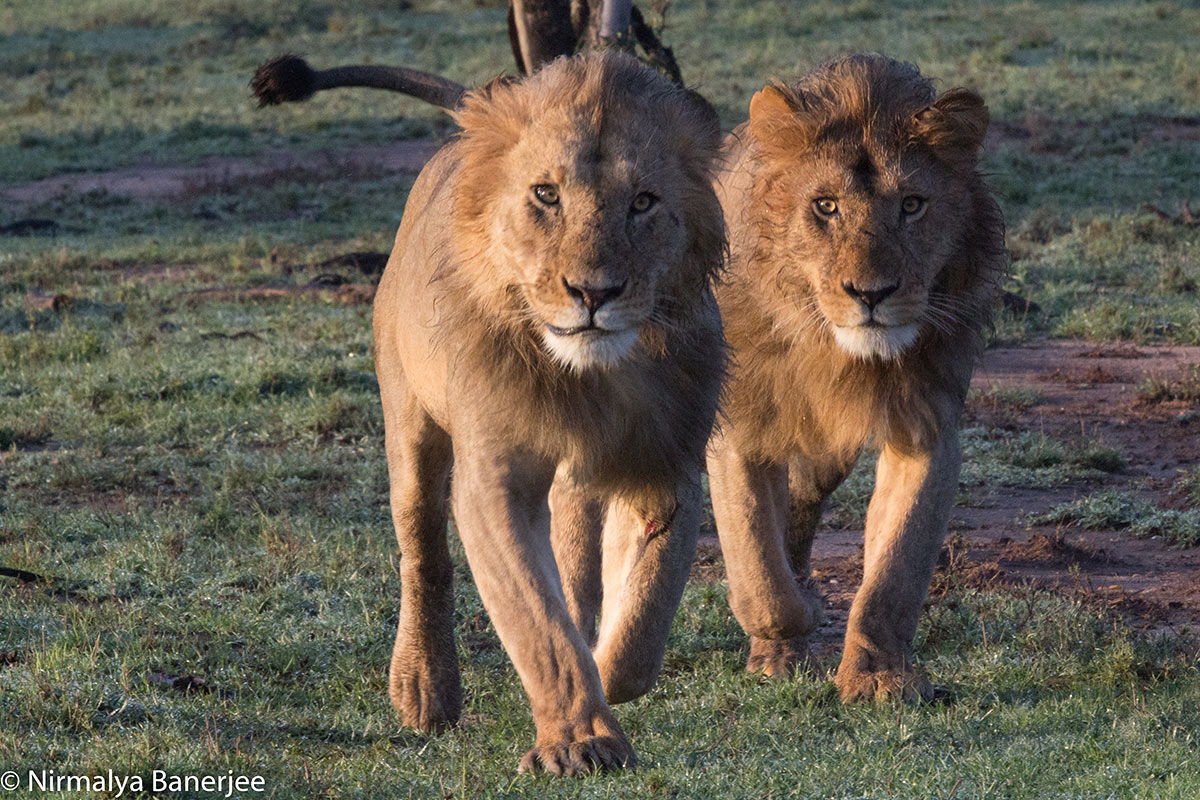
Senteu (with the scar on his left foreleg) leads Olonana

Batian has the lightest coloured mane, of the three.
Presenting the BOS brothers! Long may they rule over the conservancy and may they live up to the proud legacy of King Notch, their forebear.
Monday 15 January 2018
Notch on Notch
The Fig Tree nomads – great grandsons of Notch – came to the Ol Kinyei conservancy a little over six months ago. While they have had a free run of the conservancy so far, they have had to tolerate the occasional incursion by the Rekero males from the neighbouring Naboisho conservancy.
Dongo and Caesar II are formidable lions indeed and have forayed far and wide – as befits the descendants of the legendary Notch.
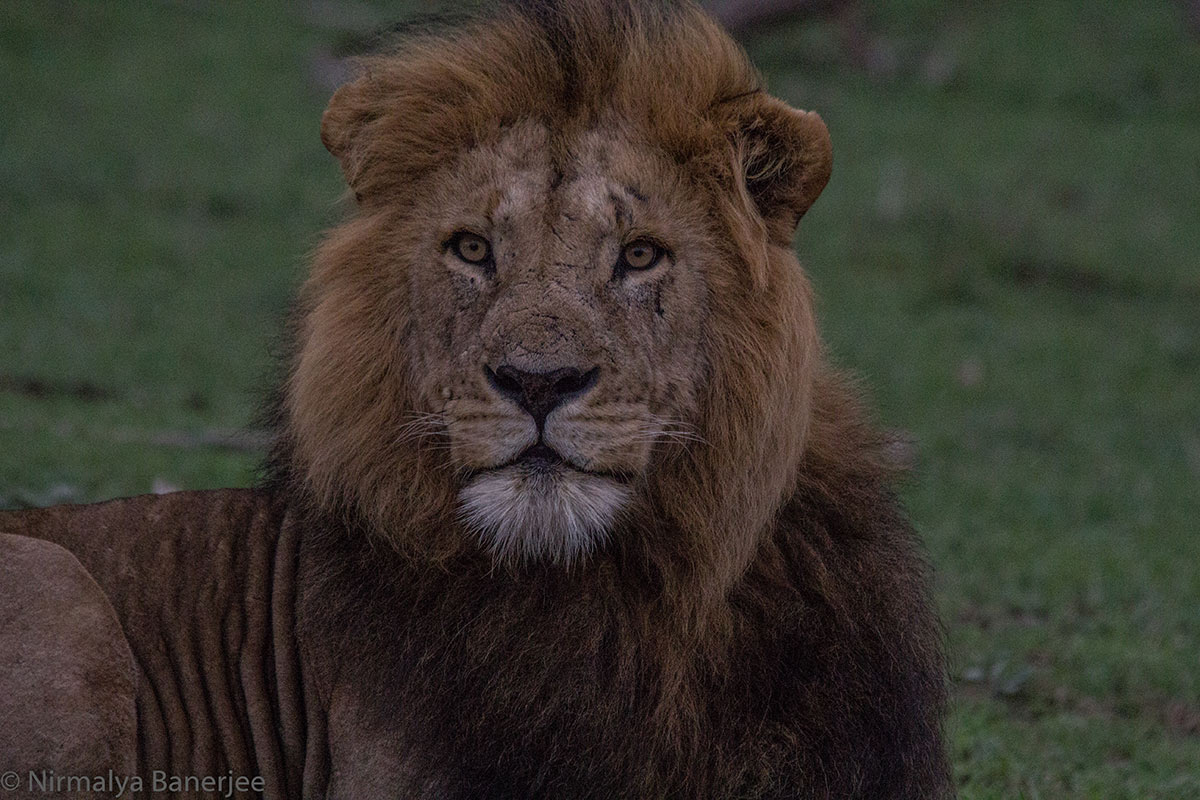
Caesar II, Rekero male
But they may have finally found their match – fittingly in their relatives, also Notch’s descendants. Last evening, we saw Caesar II (a Rekero male lion) deep within the Ol Kinyei conservancy, mating with a Nempiris, a lioness in our conservancy. At about 8 pm we heard plenty of roaring from the camp and later one of our guides who passed that way said he had seen a Fig Tree boy with a lioness exactly where we had seen Caesar II in the evening. We immediately assumed that our guide had made a mistake because he had expected to see a Fig Tree nomadic lion there. So, imagine our surprise this morning when we went looking and found a Fig Tree nomad mating with Nempiris. And then we learnt that Caesar II had been seen moving back to Naboisho conservancy. Clearly, he had been driven out by the Fig Tree boy standing his ground.
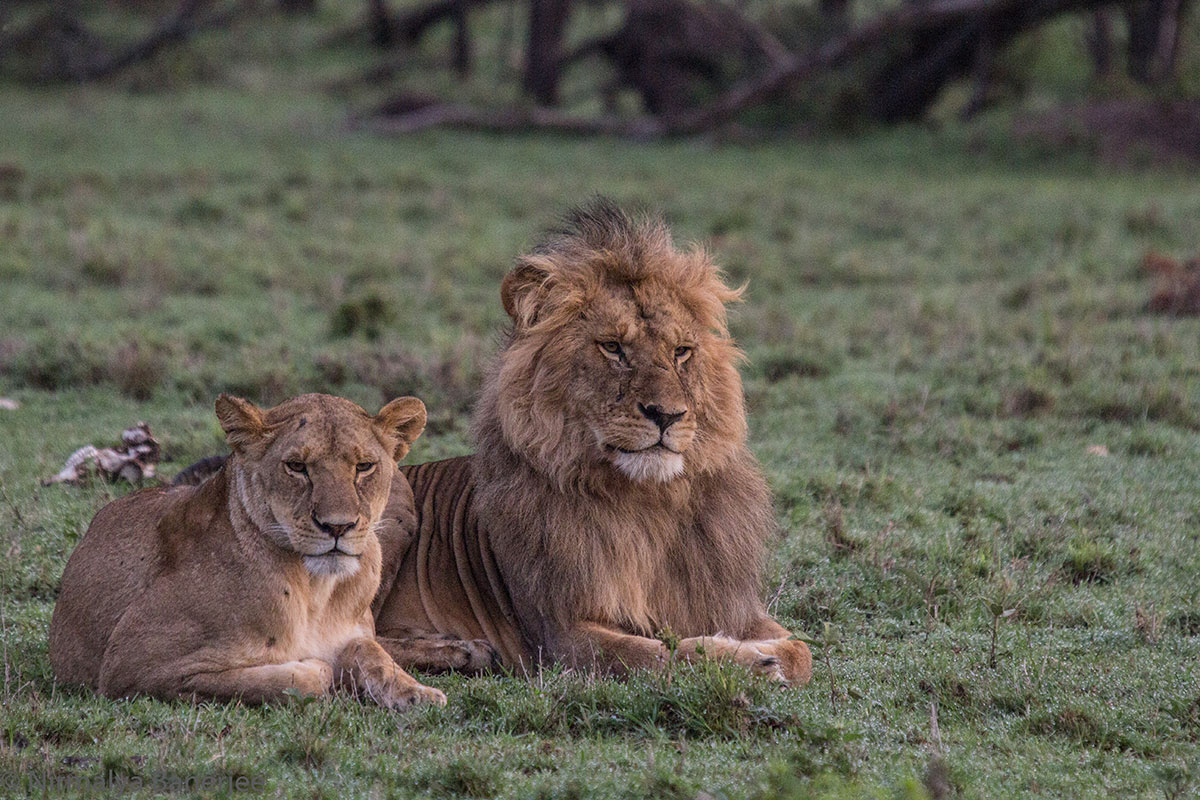
Fig Tree nomadic male lion with Nempiris
If this pattern is repeated, this is big news indeed as it shows the Fig Tree boys coming of age and being able to defend their territory against all comers. But would you expect any less of Notch’s great grandsons?
Thursday 21 December 2017
Jackals Can Hunt Too
We often tend to think of the big cats as predators and jackals as scavengers. The truth is that given the opportunity, lions will snatch carcasses killed by others i.e. scavenge and jackals will kill hares and antelope fawns for food. It all depends on the situation.
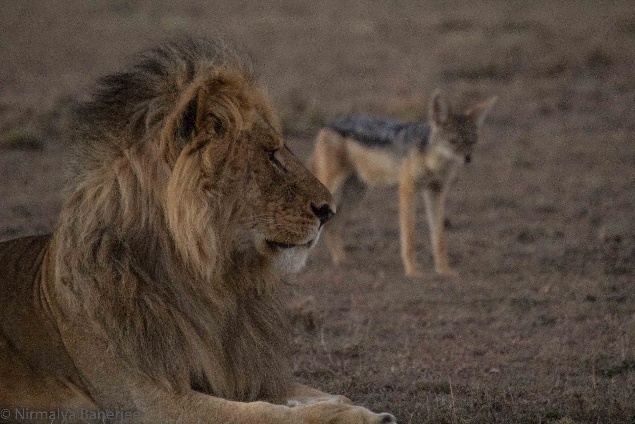
In this sequence you see a jackal that has just hunted an Impala fawn a little larger than itself.
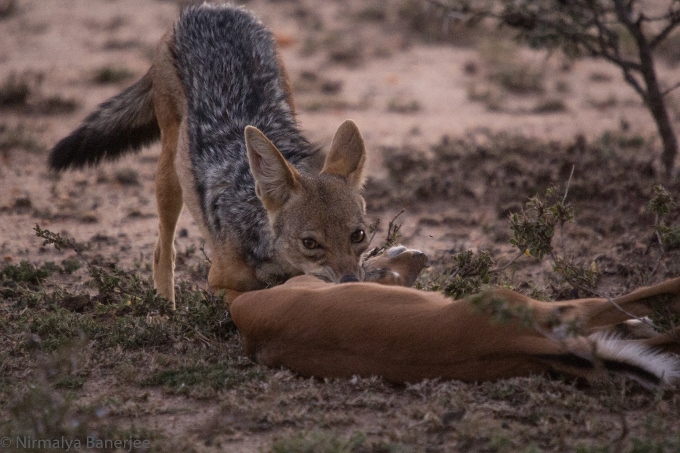

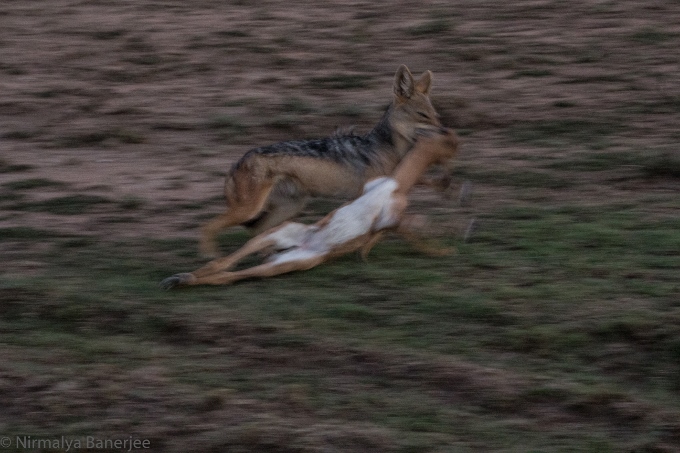
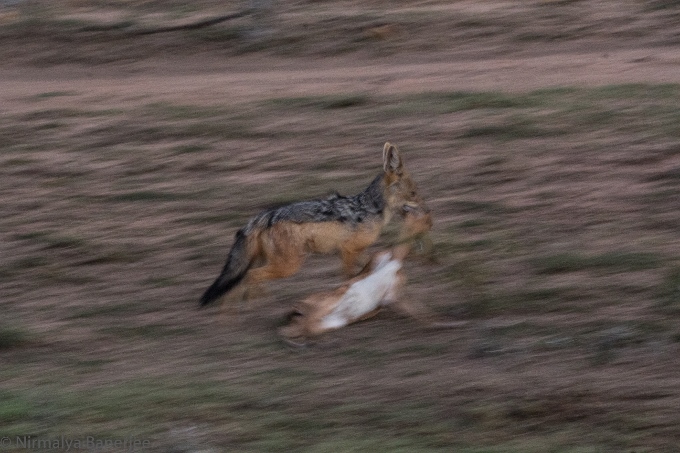
Sunday 17 December 2017
The Rekero Boys
We first saw the Rekero Boys more than three years ago, in October 2014. We were on game drive in the Masai Mara Reserve from the Porini Lion Camp and saw five young lions and a lioness not far from the Ol Kiombo airstrip. They were sticking close to the bushes almost as if scared to come out into the open. Later we learned that they had just been evicted from the Rekero pride and were probably trying to stay away from danger.

There were five young lions and a lioness, their sister who had left the Rekero pride along with her brothers. There were four brothers who were about four years old then, and one about a year younger. Even then they were a handsome set of big cats.

We stayed on with them as long as we possibly could and then left after sunset.

There are plenty of lions in the Mara and we never thought we would see them again.
The life of male lions is filled with conflict and many never survive to dominate a territory or pride. These Rekero boys turned out to be different though. We heard about them again when they passed through the Olare Motorogi Conservancy and fought some skirmishes with Lolparpit and Orbanoti, the ruling lions there.
The Rekero Boys were still young and decided against challenging these powerful lions and so moved on to the Naboisho conservancy. Somewhere along the way their sister left them and they lost one of the brothers. By 2016 they had evicted the three reigning lions of the conservancy and taken over most of the prides there.
We saw Dongo, one of the Rekero Boys, in October 2016, making a meal of a giraffe calf that he had pulled down.

Still the lions kept to the Naboisho conservancy as they consolidated their hold over the area and we rarely saw them and only while passing through the conservancy on our way to the Porini Lion Camp. And then we heard that they had started foraying into Ol Kinyei, in an effort to expand their territory. We saw one of them in September this year close to the Olare Sampu river that divides the two conservancies. He was mating with a lioness of the Sampu Enkare pride on the Naboisho side of the river.

Dongo by now is a powerful and handsome lion, dominating the entire area together with his brothers and a far cry from the young lion skulking in the bushes that we saw three years ago. It was only a matter of time before this strong pride sallied into Ol Kinyei conservancy and sure enough in November there was Dongo mating with one of the Ol Kinyei lionesses inside our conservancy.

Since then these lions have been found occasionally in the conservancy, including as recently as earlier this week when we saw Dongo walking with Caesar II following him.

It looks like this coalition is destined to dominate the eastern conservancies of Masai Mara. This isn’t surprising given that these lions are grandsons of the legendary Notch who together with his sons once held sway over a large part of Masai Mara.
Wednesday 29 November 2017
We have been hearing lions calling out at night, for the past few nights, from the Porini Cheetah Camp. Last night the lions seemed to be very close and so this morning we went on game drive to try to locate them.
We crossed the Olare Lemun, the seasonal stream that flows past the camp and crossed into the Olelentiol area of the Ol Kinyei conservancy. Olelentiol is dotted with bushes and so it isn’t easy to spot lions from a distance. We had been looking for about 30 min and found ourselves just behind the Porini Cheetah Camp when we noticed a herd of Impala, looking in the same direction with a fixed gaze. This is usually a good indication of the presence of predators and so we redoubled our efforts. It wasn’t long before we spotted an Ivory Tree male lion and a lioness from the Ol Kinyei pride.

They were sitting under some bushes and virtually impossible to see from a distance. They were obviously a mating pair. Soon they got up and started walking.

They walked to a pool of water and had their fill.

They continued on their way till they were less than 25m from the Porini Cheetah Camp. If you look closely you will see tents behind the acacia trees.


Soon they walked up a rocky ridge where we couldn’t follow and so had to bid adieu to the lions on honeymoon.
We were happy to have been able to see the lions from the other side of the camp.
Saturday 25 November 2017
Our good deed for the week, last week
Simon Nkoitoi, the conservancy warden, found this zebra separated from its herd, hardly able to move and stoically awaiting an attack from the cats.
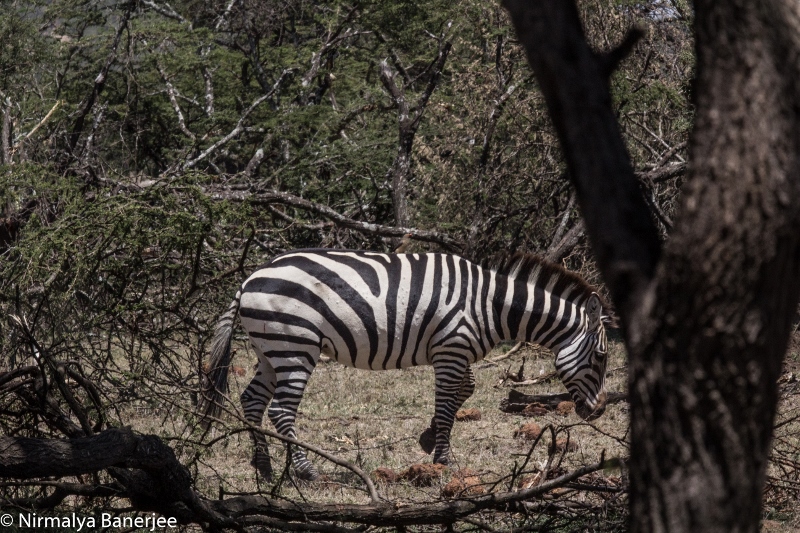
On closer look, we could see a wire round its foot that had bitten deep- perhaps picked up when the zebra had run into a wire fence outside the conservancy. Luckily a Kenya Wildlife Service vet was at hand to attend to the injury after darting the animal.
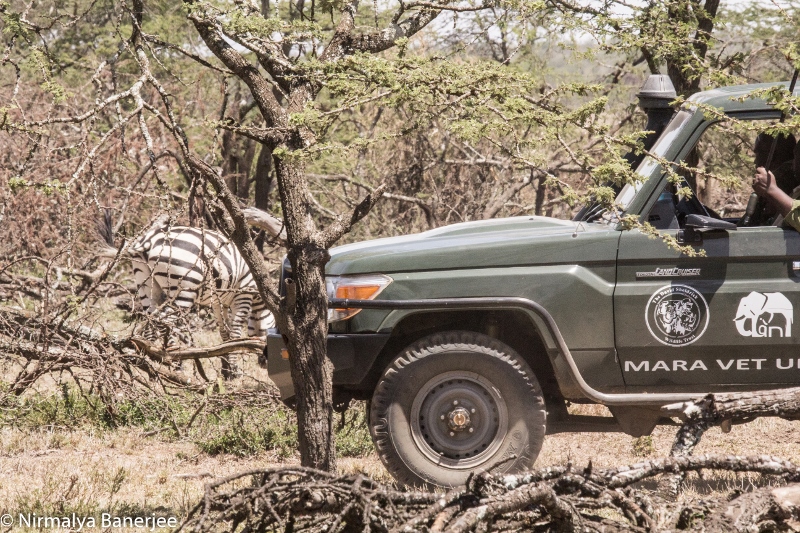
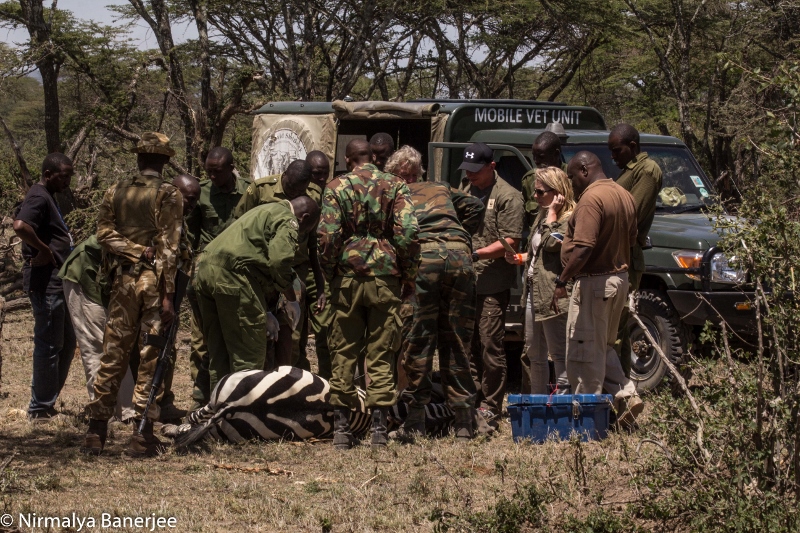
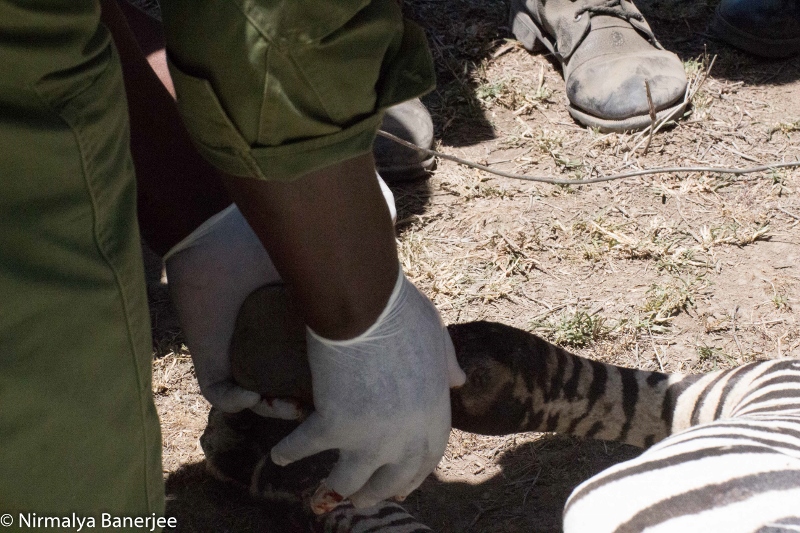
It was very nice to see it get up and walk away after it had recovered from the effect of the anaesthesia. If you look closely at the last photo of the zebra walking away, you can see the blue poultice applied by the vets.
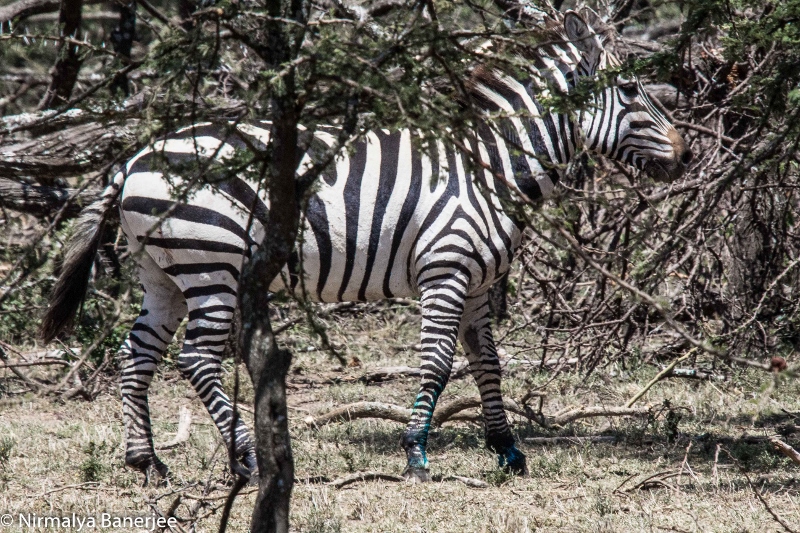
In the video you can see the zebra first hobbling badly before collapsing on being darted prior to receiving treatment.
Friday 17 November 2017
Never a dull moment in the bush
All day yesterday, we could hear a mating lion pair roaring very close to the Porini Cheetah Camp. And we could see a very large herd of elephants on the plain across the stream, from the lounge. So, when we left on a game drive in the evening it wasn’t surprising that we soon came across a herd of over a hundred elephants.
The herd was serene, and we drove in, keeping a respectful distance all the while. We never felt threatened in any way and soon we were surrounded by elephants calmly going about their business of eating. After about an hour in the company of the giants, we decided to see if we could find the mating lions. We never did find them but saw a male lion not 25m from the Porini Cheetah Camp.
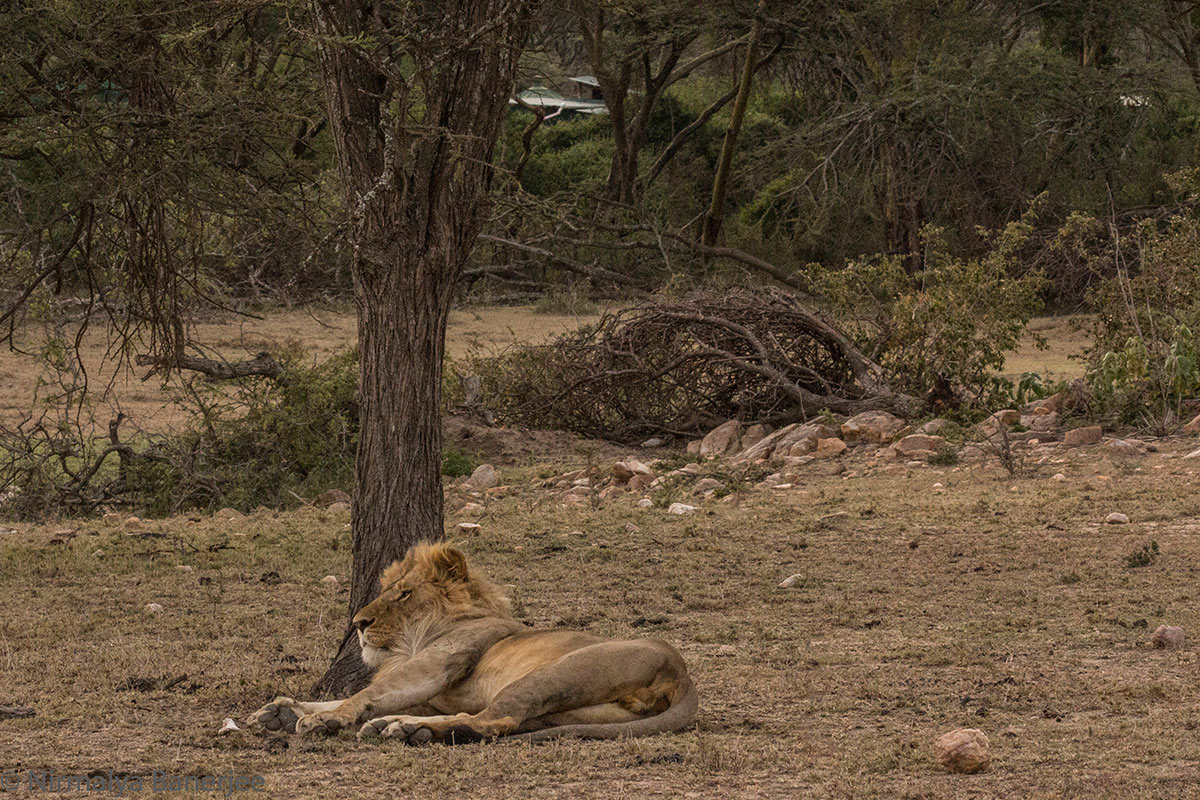
He was more than half asleep. You can see the top of one of the staff houses in the background. We waited but when even at sunset the lion showed no sign of waking from slumber, we decided to call it a day and return to the camp. After dinner we went to our tent and prepared to go to sleep. Or so we thought.
The lions were roaring not far from the camp and soon we could hear the crash of branches being pulled down close to our tent. We dragged ourselves out of bed and from the verandah of our tent, could see elephants feeding on the acacias around the marsh. We could see just a few but could hear many more. Evidently, that herd of elephants we had seen in the evening had wandered very close indeed to the Porini Cheetah Camp. Here’s a shot of an elephant by torchlight. It was not more than 15m away from us.

We returned to our beds to the rumbling of elephants and the sound of the crashing of branches punctuated by the roar of lions. And occasionally we could hear the rasping, sawing sound of a leopard. How often do you go to sleep, to a lullaby sung in symphony by three of the big five?
This morning all was serene. There was not an animal sound to be heard and you might have almost thought that there were none around. Unless you looked at the ridge next to the camp where you could see a single male elephant browsing as if he were left behind as a memento by that large herd of over a hundred elephants, the previous night.

C’est la vie.
Wednesday 15 November 2017
All in a day’s work
We had been in Nairobi for a few days and away from the camp. As we drove to the camp we saw a herd of elephants browsing nearby. Here’s a photo of one of the elephants taken from between the gum pole pillars of our water tower.
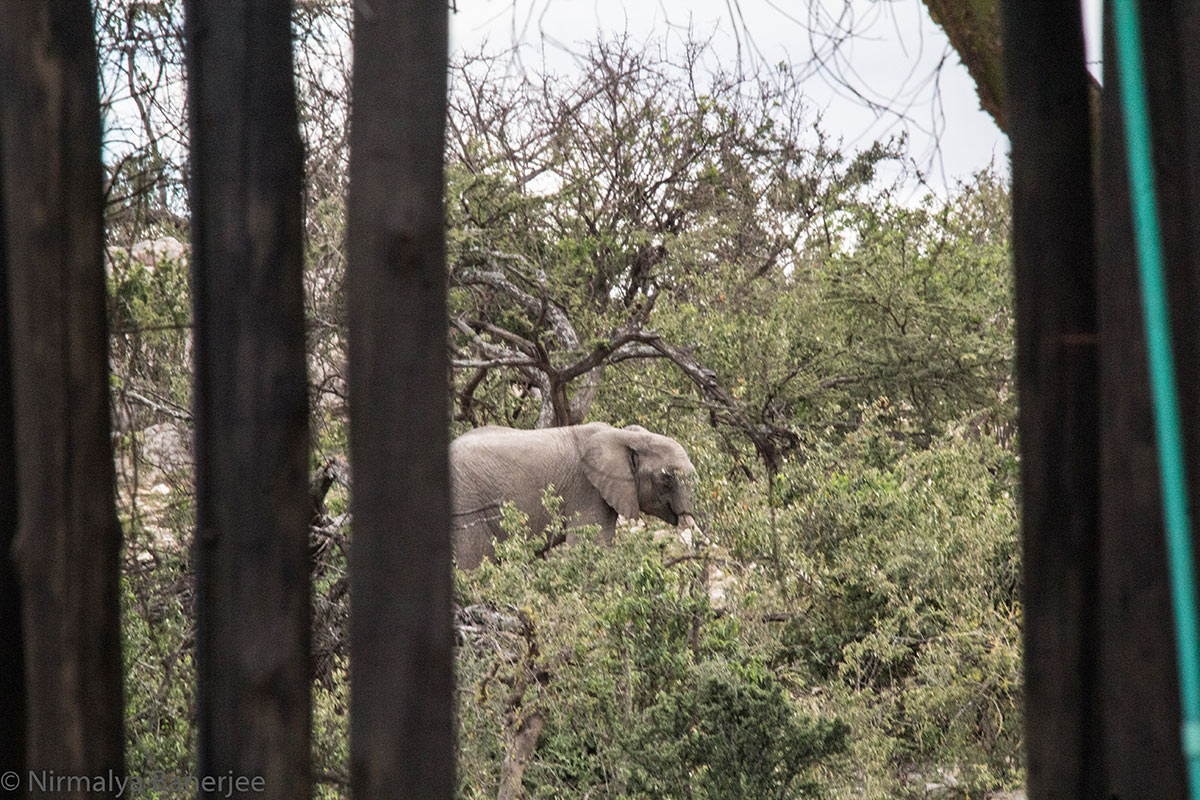
It was getting close to sun set, so we thought we’d go on a short game drive. A few minutes later we came across a mating lion pair.

Turning back, we saw the setting sun obscured by the clouds but in covering the sun, it was as if the clouds had been set alight.

Dusk is very short on the equator and the light fell rapidly. Just then, a giraffe walked past us. We saw it silhouetted by the afterglow of the sunset.

It’s good to be back at home in the bush!
Sunday 29 October 2017
Fig Tree pride boy almost fully recovered now
The limping lion I wrote about earlier has now recovered almost completely. We saw him this morning with his two brothers and while he is still lagging behind them, his limp has disappeared almost completely and can be seen only if you look closely. He’s in no discomfort and looks like he can hunt with his brothers, once again. Lions have amazing powers of recovery but even so, it’s good to see this big cat in fine fettle.
Tuesday 17 October 2017
The Fig Tree Boys
We first saw the three Fig Tree pride lions in the Ol Kinyei conservancy about four months ago.

They had been born in the Fig Tree pride that stays in the Ol Kiombo area of the Masai Mara main reserve. The siblings had started out as four brothers but somewhere on their way to the Ol Kinyei conservancy, had lost one of their number. Young male lions face a fraught period in their lives after they are evicted from their natal prides.
This is an excellent example of natural selection at work and only the strongest lions survive the period when they are on their own and get to become pride males. Still, these lions are the descendants of Notch- who once held sway over a large portion of Masai Mara so we’re hoping they’re carrying strong genes to our conservancy.

The Fig Tree boys settled in and recently we have seen them mating with a small group of three lionesses that live in the conservancy.
And then at the end of August, one day in Porini Cheetah Camp, the calm of the morning was shattered by a loud roar. We went running to one of the tents that seemed to be in the direction of that roar and saw first one and then another lion running fast. They passed perhaps 50m from the camp and there was no further action. We jumped into a pickup and followed the two lions we had seen till we reached the open plain about 200m behind the camp. There we saw the two running lions- nomads from the Sampu Enkare pride- facing off the three Fig Tree boys. The Sampu Enkare boys retreated leaving the Fig Tree trio, victors without a fight.

Since then we have been seeing the Fig Tree boys very often. About ten days ago we saw them with one of the brothers hobbling so badly that he was hardly able to walk. We thought it might be a bad thorn but couldn’t be sure that no bones were broken. Still his two brothers were solicitous about him and walked slowly to ensure that he could keep up with them.

Lions have amazing powers of recovery though and when we came across two of the three brothers earlier this week, were pleasantly surprised to see that the injured lion was much better. He still had a slight limp but the improvement was dramatic. He looked well-fed which means that his brothers must have shared their food when he was unable to hunt.

We hope he recovers fully and in a year or two expect to see the three brothers leading their own pride.
Thursday 5 October 2017
One of the enduring joys of watching wildlife is to see the young animals grow up. While the herbivores are too numerous to identify and track, it’s much easier with the cats. We first saw Nabor the cheetah’s cubs- a boy and a girl- in October 2016 when they were about eight weeks old and much smaller than house cats, obediently following their mother on long treks on the savanna.



Cheetahs must keep moving to stay away from lions and hyenas.

The cubs knew this well and so stayed close to Nabor only occasionally getting distracted by a tree to climb it. After all, cats will be cats!

And then the three must have walked away to another part of the Mara because search as we might, we didn’t see Nabor for many months. We saw them again in March 2017 still sticking close to Nabor.

They were looking keenly at some warthogs in the distance and we lost them when they started stalking through the bushes.
And then we found them again earlier this week. Now about thirteen months old, they are still much too young to be on their own, but have apparently separated from their mother. The siblings are sticking close to each other and seem to be able to hunt for themselves. We have our fingers crossed and hope they will stay out of harm’s way, grow up and add to our cheetah population. They were drinking water at Roberts’ stream

when the boy suddenly left to chase a small antelope.

He missed but perhaps got disoriented and forgot where his sister was, and started calling out to her. He soon remembered though, and went back to the stream to continue where he had left off.

The Cheetah’s chirp is a bit like a bird’s, when calling out to other cheetahs. In this video clip you can hear- and see- the male cub calling out while in the background is the distinctive alarm call of the Vervet monkeys made when they see a big cat!
Monday 2 October 2017
We woke up this morning to see a herd of elephants about 20 meters from our lounge tent. They were feeding quietly. Then they moved away a bit and had a mud bath. We watched from the camp as the whole herd moved past and headed for the shade of the nearby forest. It’s not 9 o’clock yet. What a start to my Monday!
Then later on at noon, we had another big herd of 70 odd elephants stream past close to our camp barrier and assemble nearby just below the camp.
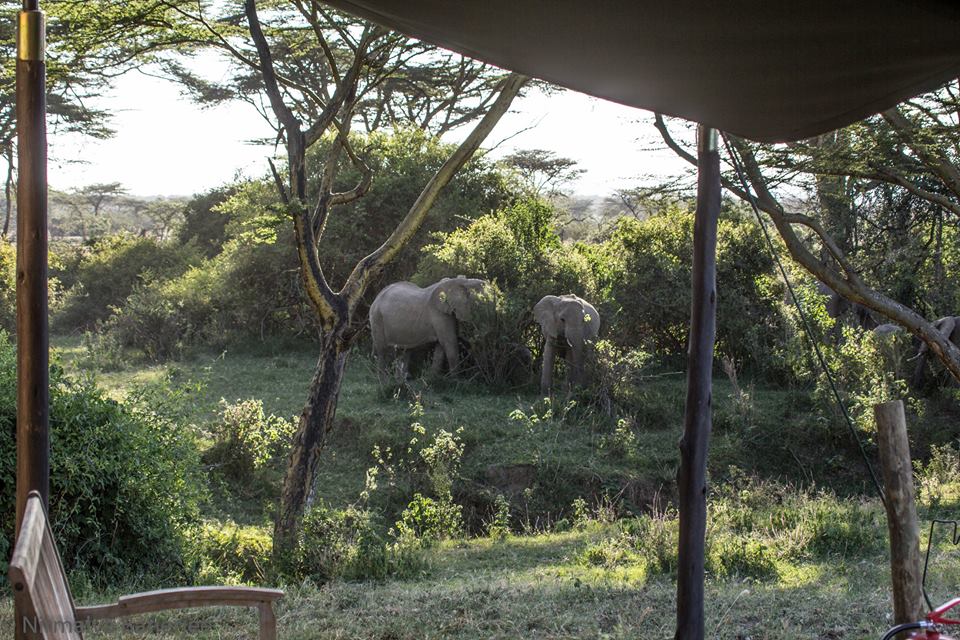
The still photo was taken from the verandah of my tent; the video from just inside the camp’s barrier. What a day it has been!
Wednesday 27 September 2017
It would be a quiet morning, we thought. All our guests had left on their morning game drives- some with picnic breakfast- and we had got in a team of groundsmen to trim the undergrowth from the many bushes that we have on the camp’s grounds. It was all quiet except for the sound of the wind rushing through the foliage of the Yellow-bark Acacia trees. And the clink-clink sound of the groundsmen using their long and straight grass-slashing knives to tidy up the grounds. I could hear all this as I worked in my tent-office.
Suddenly one of the groundsmen came running into my office, almost stumbling over in his excitement. “Lots of elephants coming straight to the camp,” He exclaimed! I went running out, only stopping to grab my camera on the way. All the gardeners followed me. Elephants usually avoid human habitation but there was a herd of fifty odd elephants calmly marching towards our camp.
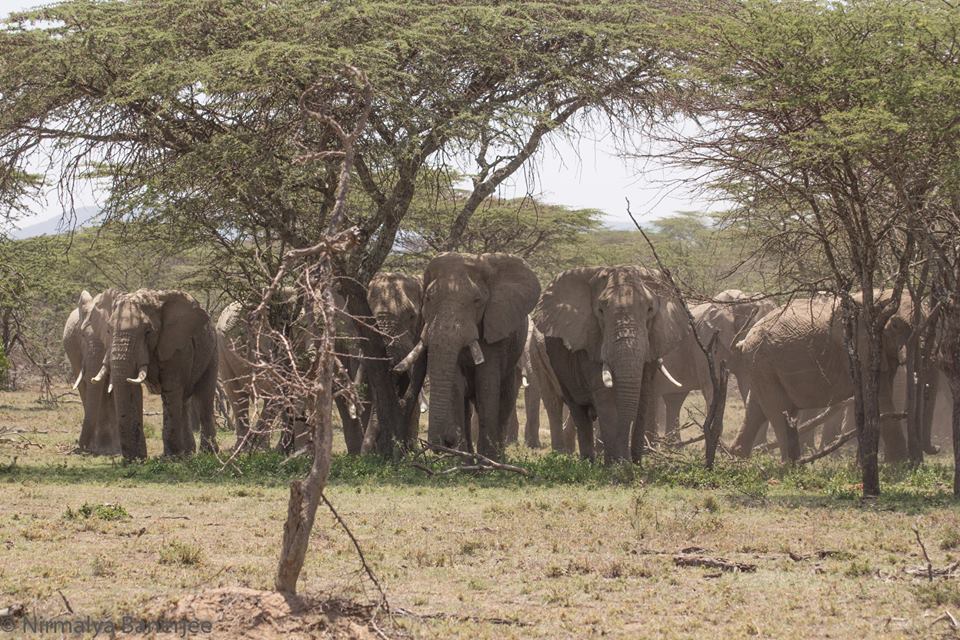
Elephants have herd memory so the matriarch was perhaps leading her herd down a traditional route that was now blocked by the brand-new camp. We watched with almost morbid interest to see what would happen next. Would the elephants rampage through the camp, flicking our cars and tents to one side and out of their way?
The leader who had till now seemed oblivious to the obstruction ahead, came to a halt, looked at us, flapped her ears and waved her head from side to side while she processed the new information. For many minutes, we waited with bated breath while the rest of the herd patiently awaited her decision. And then the other shoe dropped. With a final wave of her head, she signalled the new direction to her followers who complied and the whole herd swivelled smoothly, as if it were a single large organism. And then it was off, like a well-trained marching contingent.
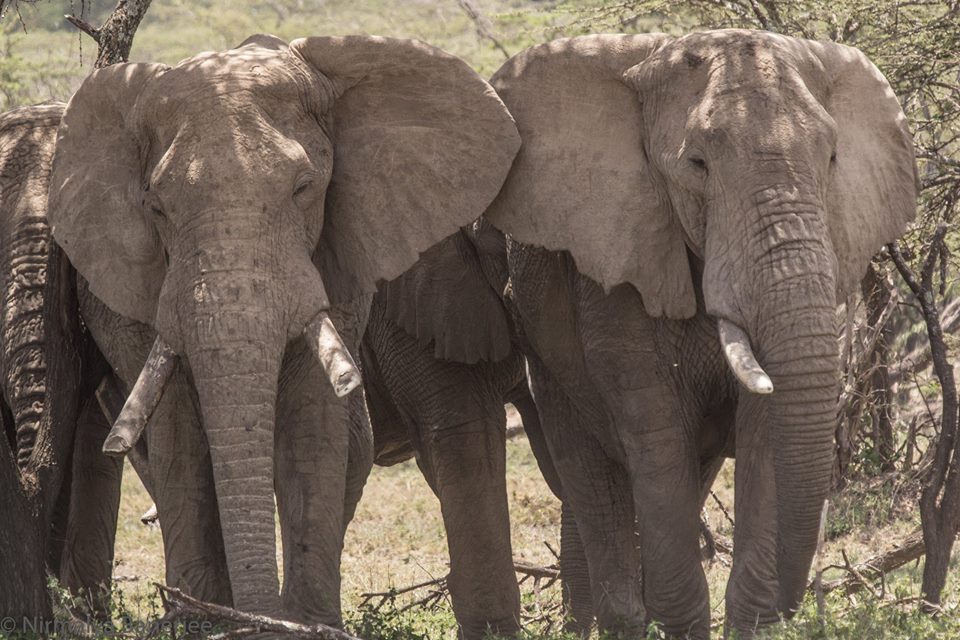
Feeling not a little relieved, I walked back to my office where I could still hear the wind swishing through the branches of the Yellow-bark Acacia trees. And the clink-clink sound as the groundsmen resumed their work.
on Tuesday 17th July 2018 at 12:24



